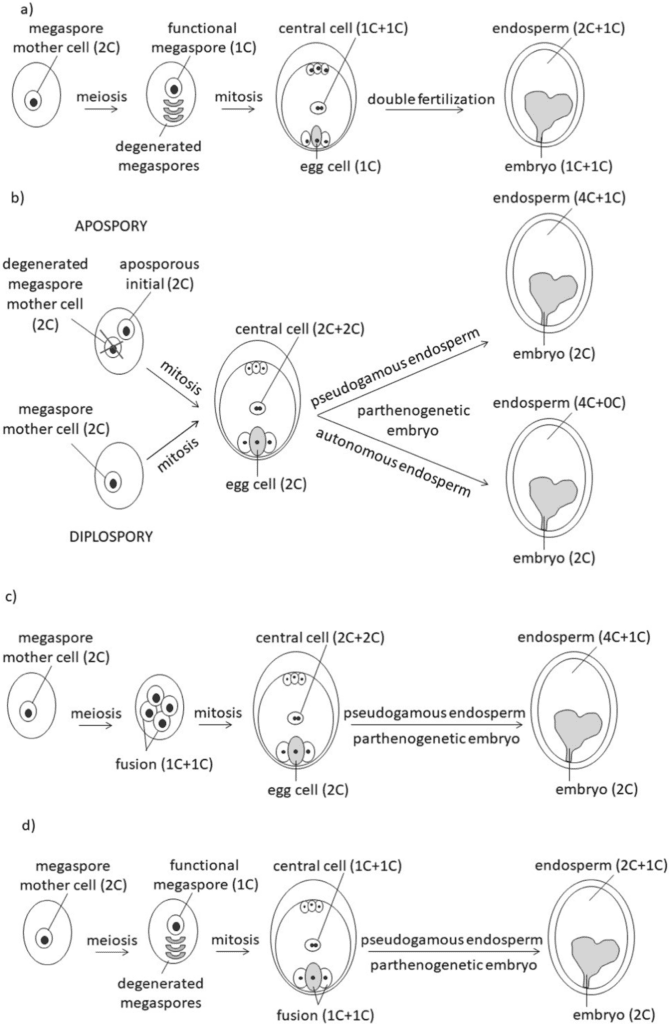A novel strategy was designed by scientists from Masaryk University, Czech Republic to identify the mode of plant reproduction. New approach combines Flow Cytometric Seed Screen (FCSS) and SSR-seq methods at the single-seed level which proved very useful for plant biology researchers.
The research was published in Plant Reproduction journal under the title of A novel strategy to study apomixis, automixis, and autogamy in plants.
Table of Contents
Why determination of mode of plant reproduction is required
Plants adapt various mechanisms during sexual and asexual reproduction to the effective regeneration of their progenies. Identifying the mode of reproduction in plants is crucial for various reasons. Firstly, it helps in understanding the genetic diversity and evolutionary strategies of plant species to breed more variants.
Secondly, knowing the reproductive mode is essential for conservation efforts, as it enables the assessment of genetic viability and population dynamics of endangered species
Overall, the identification of the mode of reproduction in plants contributes to both scientific knowledge and practical applications in agriculture, ecology, and conservation biology.
Present techniques to determine mode of plant reproduction
In recent years, the asexual mode of plant reproduction particularly Apomixis has gained much attention as it enables the preservation of the mother plant’s genotype in offspring. Many types of asexual reproduction prevail in plant species known as apospory, diplospory, parthenogenesis, and adventitious embryony.
Currently, researchers use a rapid method for confirming the mode of asexual reproduction in angiosperms known as Flow Cytometric Seed Screen (FCSS). This method determines the types of asexual reproduction (Apomixis) through extrapolating the origin of the embryo and endosperm in comparison of relative genome sizes of embryo and endosperm (In sexual reproduction, this ratio is 2C:3C).
However, certain apomictic species exhibit considerable variability in the ploidy level of the endosperm resulting into FCSS does not always provide an accurate reflection of the actual origin of the seed.
You may also like our other blog post: Biochar from Crop Residue is effective for Sustainable Greenhouse Farming: New Research
New approach to determine mode of plant reproduction
Recently, scientists from Masaryk University, Czech Republic developed one novel method to determine the the mode of reproduction where flow cytometry loses its potential. It provides a reliable and cost-effective method with significant potential in biosystematics, population genetics, and crop breeding.
This novel approach combines flow cytometric seed screen (FCSS) and genotyping of every single seed (SSR-seq) and offers a cost-effective approach to detecting complex reproductive pathways in flowering plants.
The study was carried out in Taraxacum and Rubus ulmifolius plants and scientists found, that this technology applies not only to sexual plants or sexual progeny of facultative apomicts but also to apomictic progeny in pseudogamous taxa through endosperm genotyping, and this, we can also eliminate the need for challenging seed germination in some instances.
As reported in research publication, SSR-seq analysis of the seeds method may serve as an attractive alternative to FCSS, where FCSS cannot differentiate between apomictic and sexually derived progeny.
Different mode of plant Reproduction
Plants employ various modes of reproduction to ensure their survival and spread. Here are some of the primary modes
Sexual Reproduction:
Sexual reproduction in plants involves the fusion of male and female gametes to produce offspring with genetic variation. It typically begins with pollination, where pollen grains containing male gametes are transferred to the stigma of a flower, either by wind, insects, birds, or other agents.
Once the pollen grain lands on the stigma, it germinates and forms a pollen tube, allowing the male gametes to travel to the ovule located in the ovary of the flower. Fertilization occurs when a male gamete fuses with a female gamete inside the ovule, forming a zygote.
The zygote then develops into an embryo within a seed, along with the endosperm and protective seed coat. This process ensures genetic diversity within plant populations, promoting adaptation to changing environmental conditions and enhancing the overall fitness and survival of plant species.
Asexual Reproduction:
Asexual reproduction in plants involves the propagation of new individuals without the fusion of gametes (sex cells) and the formation of seeds. Instead, plants employ various vegetative structures such as stems, roots, and leaves to generate clones of the parent plant.
This process allows rapid multiplication and propagation of desirable traits without the need for pollination or fertilization. Examples of asexual reproduction mechanisms in plants include runners, rhizomes, tubers, bulbs, offsets, suckers, and fragmentation.
Asexual reproduction is particularly advantageous in stable environments where genetic diversity may not be crucial, and where resources are readily available for the development of offspring.
Apomixis
Apomixis is a form of asexual reproduction in plants where seeds are produced without the process of fertilization. Unlike sexual reproduction, where genetic recombination occurs through the fusion of male and female gametes, apomixis allows for the development of seeds from the maternal tissue without the need for pollination or fertilization.
In this process, the embryo develops from an unfertilized egg cell or other somatic cells within the ovule, bypassing the formation of gametes. Apomixis ensures genetic uniformity in offspring since there is no contribution from pollen, and it can be advantageous for plants in stable environments where genetic variation may not be as crucial.
This reproductive strategy is observed in certain plant species, including some grasses, dandelions, and citrus plants, and it provides an efficient means of reproduction, particularly in environments where pollinators are scarce or unreliable.


More Information: Šarhanová, P., Majeský, Ľ. & Sochor, M. A novel strategy to study apomixis, automixis, and autogamy in plants. Plant Reprod (2024). https://doi.org/10.1007/s00497-024-00499-6
